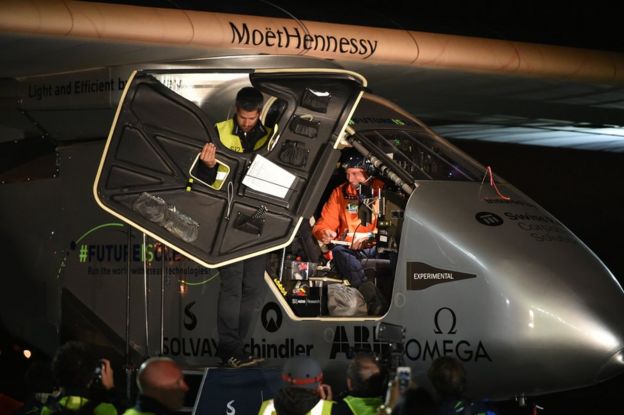- 55 minutes ago
- Science & Environment
-
(과학/환경) 솔라 임펄스 태평양 횡단 성공과학과 테크놀로지/과학 2016. 4. 24. 19:22
출처: http://www.bbc.com/news/science-environment-36122618
Solar Impulse lands in California after Pacific crossing
 AFP
AFPThe fuel-free plane is one leg closer to to ending its round-the-world trip (to to에서 하나는 빼야 함. 오류임.) The solar-powered aeroplane Solar Impulse has landed in Silicon Valley, California, after a three-day flight over the Pacific Ocean from Hawaii.
High winds delayed the landing at Moffett Airfield, Mountain View, as pilot Bertrand Piccard flew in a holding pattern off the coast.
"The Pacific is done," he declared just before landing.
The latest leg of the round-the-world flight was the riskiest yet because of the lack of emergency landing sites.
Fellow pilot Andre Borschberg hugged Mr Piccard when he stepped from the cockpit.
Google boss Sergey Brin was also at the airfield to greet him. "It was a beautiful landing, we were right there watching," he said in a clip tweeted by the plane's media team. (airfield: 군용기나 개인비행기가 이착륙 하는 곳)
All from the sun
"You know there was a moment in the night, I was watching the reflection of the moon on the ocean and I was thinking `I'm completely alone in this tiny cockpit and I feel completely confident'," Mr Piccard told reporters afterwards.
 AFP
AFPBertrand Piccard smiled as the cockpit door was opened "And I was really thankful to life for bringing me this experience, It's maybe this is one of the most fantastic experiences of life I've had."
He predicted that, 50 years from now, electric aeroplanes would be "transporting up to 50 people".
With 17,000 photovoltaic cells on its top surfaces, the plane gets all its energy from the sun. These power the craft's propellers during the day but also charge batteries that the vehicle's motors can then call on during the night. (photooltaic cells: 광전지) (power: 동력을 공급하다. 작동시키다)
Solar Impulse started its journey in March of last year in Abu Dhabi, with the two pilots taking turns in the cockpit.
 AP
APThe plane could be seen over San Francisco on Saturday evening local time 
It crossed Oman, India, Myanmar and China before flying to Japan, from which it undertook the 8,924km (5,545-mile) passage to Hawaii.
That five-day, five-night crossing set a record for the longest ever non-stop solo aeroplane journey.
Bertrand Piccard: "We've learnt that we can make a plane that can fly forever" However, the vehicle's batteries overheated, forcing the project to stop on the Pacific archipelago for eight months while repairs were conducted.
A further 20m euros (£16m; $23m) had to be raised from supporters during the winter to keep the project going for another year. (2,300만불=약 230억원 소요)
New York next
It was Mr Borschberg who flew into Kalaeloa last July and he will take the controls on the next leg across the US mainland.
The two Swiss pilots' intention is to reach New York by the start of June, to begin preparations for an Atlantic crossing.
Assuming this is completed successfully, it should then be a relatively straightforward run back to the "finish line" in Abu Dhabi.
 SOLAR IMPULSE
SOLAR IMPULSEThe plane underwent repairs in Hawaii Mr Piccard and Mr Borschberg have been working on the Solar Impulse project for more than a decade.
A plane wider than a 747 jumbo jet but that weighs just 2.3 tonnes poses some unique challenges:
- Low speed means mission legs can take several days and nights of continuous flight
- The pilot is permitted only catnaps of up to 20 minutes (catnap: 토막잠)
- The cockpit is little bigger than a public telephone box

LEG 1: 9 March. Abu Dhabi (UAE) to Muscat (Oman) - 772km; 13 Hours 1 Minute
LEG 2: 10 March. Muscat (Oman) to Ahmedabad (India) - 1,593km; 15 Hours 20 Minutes
LEG 3: 18 March. Ahmedabad (India) to Varanasi (India) - 1,170km; 13 Hours 15 Minutes
LEG 4: 18 March. Varanasi (India) to Mandalay (Myanmar) - 1,536km; 13 Hours 29 Minutes
LEG 5: 29 March. Mandalay (Myanmar) to Chongqing (China) - 1,636km; 20 Hours 29 Minutes
LEG 6: 21 April. Chongqing (China) to Nanjing (China) - 1,384km; 17 Hours 22 Minutes
LEG 7: 30 May. Nanjing (China) to Nagoya (Japan) - 2,942km; 1 Day 20 Hours 9 Minutes
LEG 8: 28 June. Nagoya (Japan) to Kalaeloa, Hawaii (USA) - 8,924km; 4 Days 21 Hours 52 Minutes
LEG 9: 21 April. Kalaeloa, Hawaii (USA) to Mountain View, California (USA) - 4,200km; 62 Hours 29 Minutes
'과학과 테크놀로지 > 과학' 카테고리의 다른 글
(과학) 솔라 임퍼스 오하이오 기착 (0) 2016.05.22 (과학/환경) 전세계 식물종의 최신 합계 39만종 (0) 2016.05.10 (과학/환경) 씨앗은 오랜 기간 새의 생존방법 알려주는 단서 (0) 2016.04.24 (과학) 인공강우 Rainmaking/artificial rainfall (0) 2016.04.12 (과학) Equinox (주야평분시/晝夜平分時) (0) 2016.03.27
